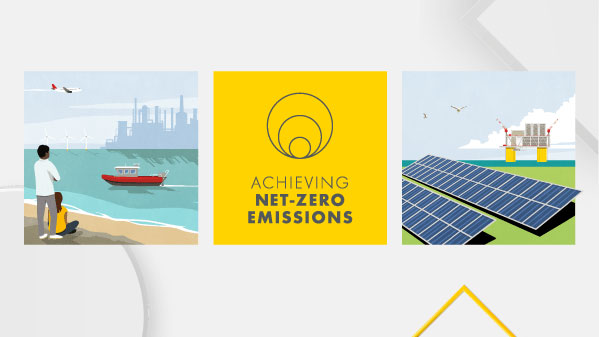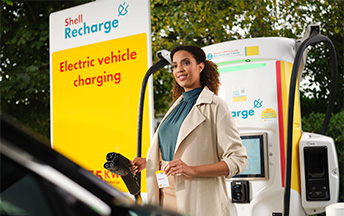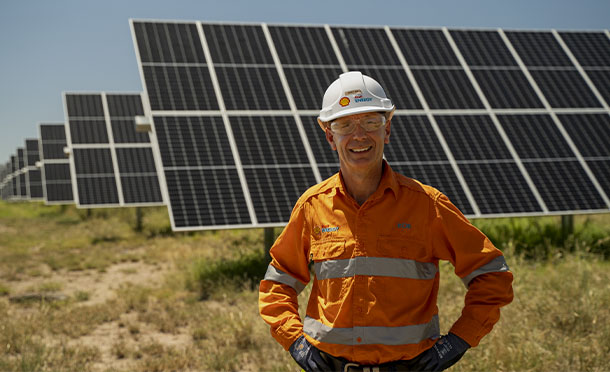Delivering our climate targets
Investing in net zero
In 2022, we invested $8.2 billion in low-carbon energy and non-energy products, around a third of our total cash capital expenditure [A] of $25 billion. Of that, we invested $4.3 billion in low-carbon energy solutions, an increase of 89% compared with the previous year. This includes capital spending on biofuels, hydrogen and charging for electric vehicles, as well as wind and solar power [B]. The remaining $3.9 billion was invested in non-energy products such as chemicals, lubricants and convenience retail, which do not produce emissions when they are used by our customers. Our investment in non-energy products decreased by 9% compared with 2021.
These investments advance a central part of our strategy, which is to sell more products with low-carbon emissions to help both Shell and our customers meet their climate targets. See our 2022 Energy Transition Progress Report and 2022 Annual Report to learn more about our investments in energy in 2022.
[A] Please refer to the Shell Annual Report and Accounts 2022 for the definition of cash capital expenditure.
[B] The $4.3 billion investment does not include the acquisition of Nature Energy for around $2 billion, which closed at the beginning of 2023.
Net carbon intensity
Shell’s net carbon intensity is the average intensity, weighted by sales volume, of the energy products sold by Shell. It is tracked, measured and reported using the Net Carbon Footprint methodology. We express our net carbon intensity as the grams of CO2 equivalent per megajoule (gCO2e/MJ) produced for each unit of energy delivered to, and used by, a consumer.
In 2022, Shell’s net carbon intensity was 76 gCO2e/MJ, a 1.3% decrease from the previous year and a 3.8% reduction compared with 2016, the reference year. The decrease in our net carbon intensity in 2022 was primarily due to an increased proportion of renewable power and corresponding reduction in the carbon intensity of our power sales. Our 2022 net carbon intensity includes 4.1 million tonnes of emissions offset through the use of carbon credits, compared with 5.1 million tonnes that were included in our 2021 net carbon intensity. The net carbon intensity only includes carbon credits that are retired against energy products.
The biggest driver for reducing our net carbon intensity is increasing the sales of, and demand for, low-carbon energy.
We undertake external verification of our net carbon intensity annually, and we have received third-party limited assurance on our net carbon intensity for the period 2016 to 2022 by LRQA. Limited assurance means nothing has come to the verifier’s attention that would indicate the net carbon intensity data and information, as presented in the Net Carbon Intensity Assertion, were not materially correct.
Read more about our Net Carbon Footprint methodology in our 2022 Annual Report and at www.shell.com/ncf.
Net carbon intensity [A] [B]
Grams of CO2 equivalent per megajoule (gCO2e/MJ)
[B] Acquisitions and divestments are included in the actual performance tracking, with the target and reference year unchanged. Note that acquisitions and divestments could have a material impact on meeting the targets.
Absolute emissions reduction performance
In 2022, our total combined Scope 1 and 2 absolute greenhouse gas emissions (from assets and activities under our operational control) were 58 million tonnes on a CO2 equivalent basis, a 15% reduction compared with 2021, and a 30% reduction compared with 2016, the base year. Our Scope 3 emissions from energy products included in our net carbon intensity were 1,174 million tonnes of CO2 equivalent.
Scope 1 and 2 emissions under operational control
Million tonnes CO2e
[B] GHG emissions were calculated using global warming potential (GWP) factors from the IPCC’s Fourth Assessment Report. For comparison, our Scope 1 emissions would have been 51 million tonnes in 2022 if we were to use GWPs from the IPCC's Fifth Assessment Report.
[C] GHG emissions in this table do not include carbon credits.
[D] We estimated the uncertainty of our 2022 Scope 2 GHG emissions to be around 7%.










